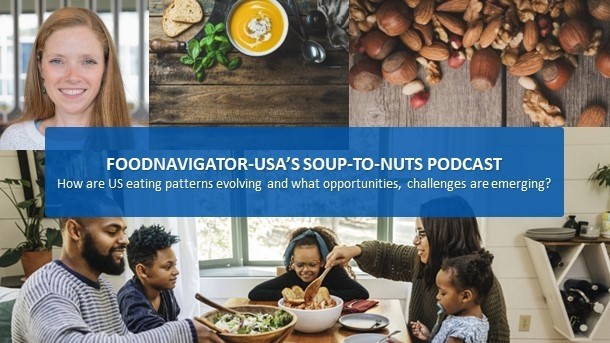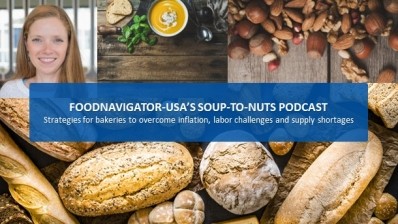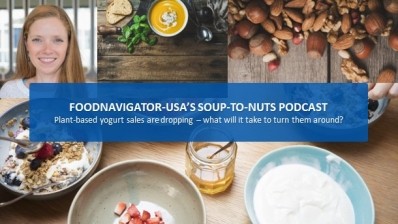Soup-to-Nuts Podcast: How are US eating patterns evolving and what opportunities are emerging?

Recently published research from The NPD Group confirms not only is the practice of eating three-square meals a day no longer dominate, but it finds Americans increasingly skip meals entirely – whether because they prefer a collection of snacks or a state of constant grazing as they balance the demands of their day or because they are trying to cut calories or costs as inflation continues to drive food prices up double-digits year-over-year. https://www.npd.com/perspectives/us-food-epa-fbc-lp-npd/
Of course, many people still eat traditional meals, but what and where they are dishing up is equally influenced by their physical and emotional health goals, time constraints, how much money they have and even their life stage.
In this episode of FoodNavigator-USA’s Soup-To-Nuts podcast, NPD food industry advisor David Portalatin shares insights from the group’s 37th annual Eating Patterns in America report, including how economic uncertainty, the pandemic, a quasi-return to ‘real life’ and our hyper-awareness of wellness are impacting eating decisions. He also shares how these shifts are creating opportunities and challenges for food and beverage brands and retailers and how they can make the most of the ever evolving situation.
[Editor’s note: Never miss an episode of FoodNavigator-USA’s Soup-To-Nuts podcast – subscribe today.]
Rising food prices present difficult choices
One of the most influential macro-trends impacting how Americans eat is inflation – which continued to rise 0.4% in October for food at home so that year-over-year grocery prices are up a staggering 12.4%, according to the most recent Consumer Price Index data released last week.
As Portalatin explains the biggest impact of inflation on food purchases is that it is pushing many Americans to trade down – but what this means depends heavily on their starting point, with more affluent consumers moving from restaurants and food service to premium retail options and lower income shoppers moving from national retail brands to private label.
In both instances, Portalatin says, there is significant opportunity for brands, retailers and even restaurants.
“There is an opportunity to obviously create value for the consumer. So, those consumers who might be trading out of the restaurant space are looking at a bigger expenditure now that will stretch further in the retail aisle, and it does create some opportunities for” more premium and higher priced items that still are less than a night out, he explained.
“On the other hand, those that are under the most economic pressure and lower income tiers are already starting to trade down even within the grocery aisle … and so the key is to understand who the consumer is, across that spectrum, and create opportunities for them to have value driven food choices,” he added.
Despite high inflation and some trading down, consumers in general are still spending the same amount on groceries as a they were two years ago, according to data from FMI – The Food Industry Association – a phenomenon that Portalatin attributes to government stimulus money that helped line consumers savings accounts and a relatively strong employment market.
But, as stimulus funds drain down and concerns about layoff increases, industry could see another shift in dietary patterns, he said.
“The biggest risk to the consumer right now is if anything were to happen in the macro-economic environment that would change the employment market, and if we started to see unemployment rise ... that’s when I think you’d start to see the pain become even more acute on consumers,” he explained.
Home is where the food is
The current inflationary environment also is reinforcing another macrotrend that Portalatin says was accelerated by the pandemic: eating at home more, which opens up opportunities for retailers that can offer affordable, convenient and compelling meal solutions.
“About 85% of everything that we eat or drink is coming from a retail store,” and only 15% from restaurants, and even then it more likely is consumed in the house, Portalatin said. “Now compare that to where we were a few years ago – it has been about a two percentage point shift to the at-home side of the equation, and while that doesn’t sound like a lot, remember the universe is 577 billion eating occasions.”
This is “giving a little more momentum to trips into the retail store,” he said.
Even as consumers continue to spend more time at home, mobility is returning – as are demands for time – which means convenience is becoming increasingly important.
According to Portalatin, the need for fast, easy solutions is pushing some consumers to change where they shop, including more frequent trips to c-stores, which were once dismissed other than for snacks and cigarettes, but which often now offer higher-end prepare food.
Digital commerce also is benefiting from demand for convenience, but Portalatin says the way consumers engage with ecommerce is evolving from how they did during the pandemic – with many favoring the ease of ordering online but opting to pick up their orders curbside rather than gamble with last mile delivery, which often leaves something to be desired.
Others are seeking convenience in the form of fast meal solutions or ways to recreate at home restaurant style meals that balance their desire for bold new flavors and cost-savings
Emotional well-being increasingly factors into food choices
Consumer interest in convenience is closely aligned with another macro-trend influencing food choices – wellness. Specifically, mental wellness and the idea of finding balance – be it between time and taste, energy and expense or functional nutrition and flavorful indulgence.
According to Portalatin, this is playing out by consumers seeking foods and beverages that feed both their physical well-being and their emotions.
“Consumers are still very focused on those functional aspects of health, various nutrients, how many calories, diet, exercise – all of those traditional things. What I see emerging out there is an increasing awareness that our mental and emotional health is a key component of our physical health, and just as food and beverages play a direct role in our physical health, they also play a role in our mental and emotional health,” he explained.
As such, he said, consumers are balancing diet with indulgences that support their emotional wellbeing. So, someone might skip breakfast, have a protein shake for lunch and then at the end of the day feel they deserve a bowl of ice cream.
“There are opportunities to engage consumers on both of these,” such as through snacks or products making better-for-you claims, including reduced fat or sugar or added benefits to treats, like higher protein in ice cream, he said.
Other factors and trends – both emerging and waning – constantly cause consumers to shift their food selections, and The NPD Group stays on top of them each year with its Eating Patterns in America report, which draws from several large data sets managed by the group. To learn more about the report or check out the latest edition visit www.npd.com.

















